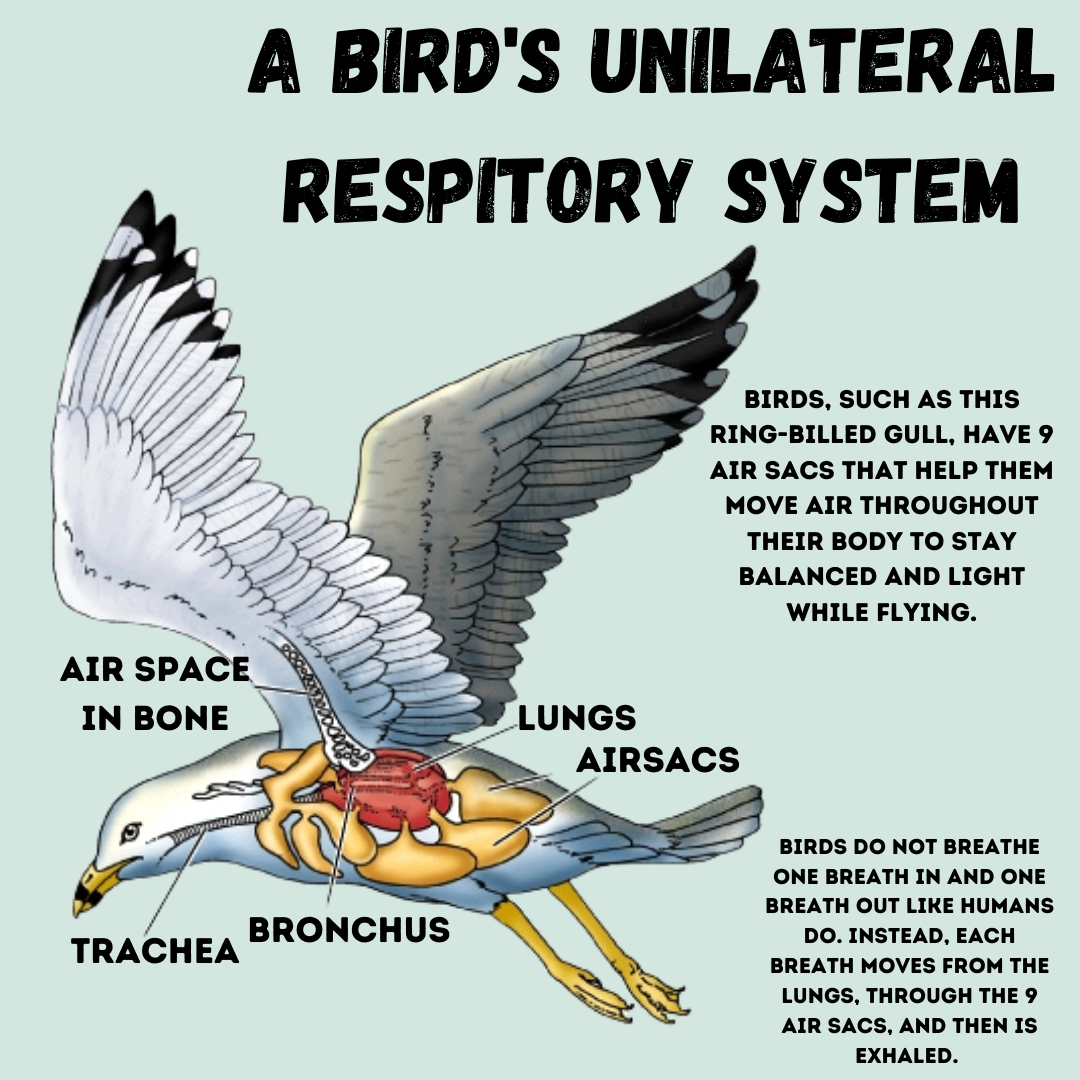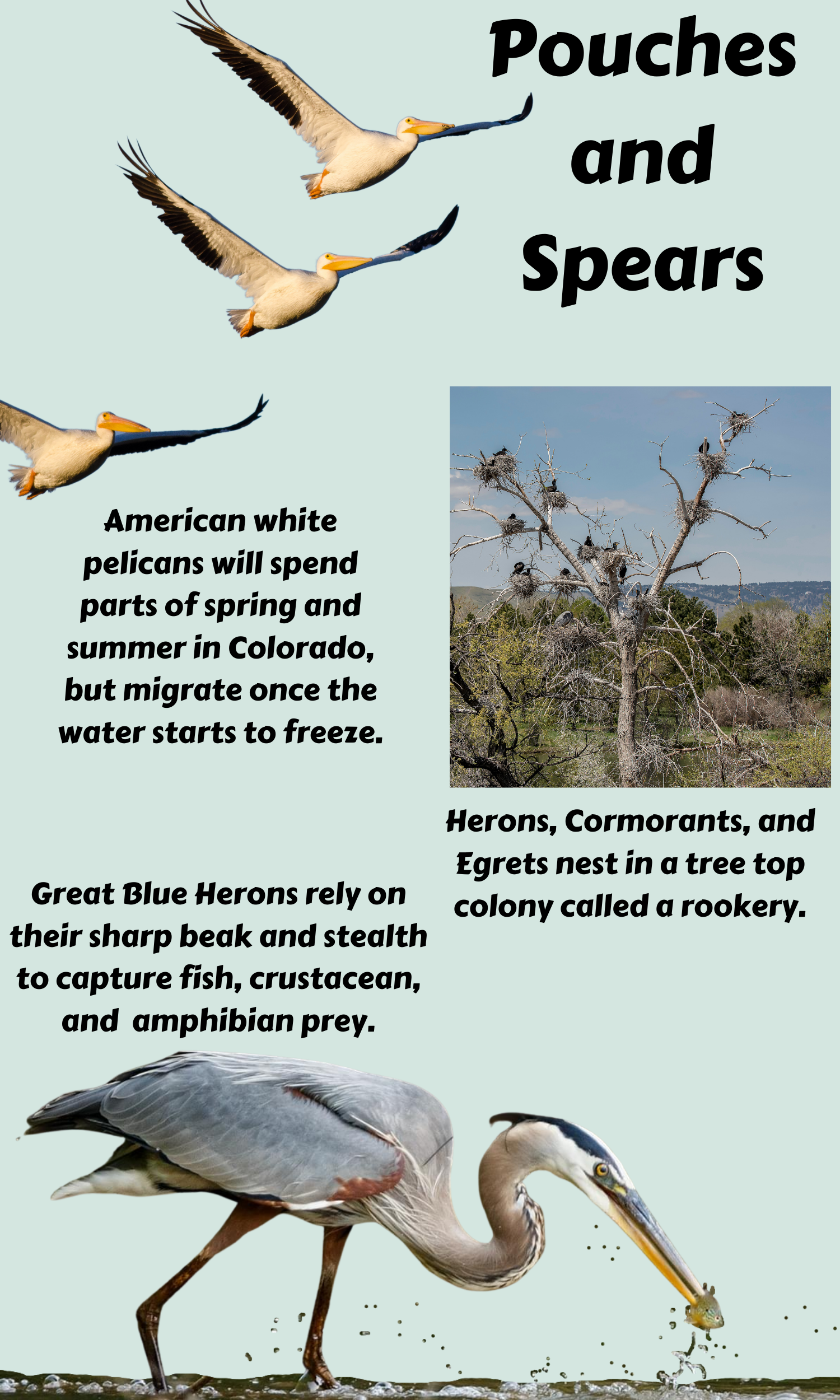Waterfowl Education Materials
American Coots
Unlike the typical webbed feet on ducks and other waterfowl, coot feet have 3-4 lobes on their toes that fold and expand. These lobes will fold in with gravity when the bird lifts its food and walks; which greatly increases its speed and predator avoidance on land. This allows the bird to safely explore habitats for prey that other waterfowl can’t. These lobes also fold when the bird brings its foot forward while swimming, which requires less energy then typical webbed feet. However, these lobes are built so they will expand when the bird pushes its foot back while swimming, giving the same burst of movement that webbed feet would bring!
Grebes and Snow Storms
Several species of grebe can be found in Northern Colorado, and they are all excellent divers because their legs are set extra far back on their bodies. This makes it super easy to for them to catch fish. However, because their legs are set so far back, they need a running take-off from water when they want to fly. This imbalance also makes it difficult for them to walk for more than a couple of steps so they can’t get out of the way for traffic easily. If you find a grebe that is experiencing these emergencies because of the snow, please contact your local licensed wildlife rehabilitator.
Beaks and Bills
While they come in many different shapes, colors, and lengths, they have the same name. The term beak and bill are synonymous when talking about bird faces. Many licensed wildlife rehabilitation teams work with the beaks of birds on a daily basis and must know how to heal them if they are fractured, how to stay safe around them while working, and how to manipulate them if force feeding is needed.
Pelican Pouches
Pelicans are gregarious meaning they prefer to be in flocks. These amazing birds can be found in Northern Colorado during the spring and summer months, and while there are 8 different species of pelican in the world, American White Pelicans are the only species found in Colorado. The biggest threat to pelicans in Northern Colorado is fishing litter. Everyone can help prevent these injuries and help do their part by picking up litter when you see it, even if it didn’t belong to you in the first place.
Rookeries
In the spring we see old rookeries come back to life with families of herons, egrets, and cormorants! Having so many individuals nest in one place provides the rookery with extra security for the entire flock; even though each family typically leaves each other alone and raises their young independently. Rookeries are federally protected by the Migratory Bird Treaty Act which means it is a felony to damage, take, or harass any of the nesting birds. This means photos should be taken at great distances using zoom lenses. A person should never take a drone near a rookery. The birds will be terrified and may attack and down it which could cause injury to them and their young. Flying drones near a nest is also considered harassment.
Canada and Cackling Geese
In 2004 some of the smallest Canada Goose subspecies were split into a whole new species all together; the Cackling Goose! While you can see by the graphic that there are large differences to warrant this change, it became known as the Canada Goose conundrum because of some differing opinions on where the line was drawn between Canada Geese and Cackling Geese. Regardless, subspecies of both can often be seen intermingling and living essentially carbon copy lifestyles. A large amount of difference comes from which areas of Canada and the US they migrate and nest.
Adaptions to Keep Warm
Birds stay warm through several adaptations. They have a fatty layer with the added benefit of several layers of feathers. Closest to their body they have down feathers which are soft and fluffy. These feathers are built to allow air to flow around them while the outer layers of rigid contour feathers traps it. This trapped air then warms and circulates around keeping the bird warm. Birds will often fluff up in the cold to increased the amount of air that is being trapped and warmed. Having skinny legs allow bird veins and arteries to be so close together that as warm blood exits the body, it’s radiant heat is able to warm the the cold blood flowing back through the leg and back into the body. They will also alternate which leg they stand on, allowing the other one to warm up close to the body.
Baby Waterfowl in Colorado
While waterfowl are all precocial, meaning they are all able to walk and eat on their own right after being hatched, each of these species is very different in their diet, stress management, and enclosure requirements. These babies rely heavily on their parents for protection and guidance so contact your local licensed wildlife rehabilitator immediately if you find an orphaned waterfowl baby. This way a rehabber can get them reunited with a family or into a facility capable of correctly raising them.
“Sea”gulls
While “seagull” is commonly used as an umbrella term for the Laridae (gull) family, there is actually no species called a seagull. Gulls are considered piscivorous meaning they primarily eat fish, but a strong argument could be made for calling them omnivorous seeing as how they also eat eggs, mollusks, and rodents. There are over 50 different species of gull in the word and some species migrate great distances, such as the Sabine’s Gull who winters in Peru and South Africa but raise their young in the Canadian arctic. You can help keep Northern Colorado’s gulls safe by picking up fishing litter, slowing down for them in parking lots, and securing any food and drink when outside.
Waterfowl on Roofs
In the spring we begin seeing more and more pairs of waterfowl mates break off from the flocks around our communities which means they are finding nest sites and will beginning to lay eggs. Every year we hear about circumstances where ducks and geese build their nests on the roofs of businesses and homes with flat, protected areas. The problem is that once these babies hatch, the parents have to walk them to the water sources they will grow up at. High ledges and high falls will prevent the ducklings or goslings from reaching the ground safely, so if this is the case, it is best to prevent them from nesting on your roof at all. You can use humane solutions such as motion activated sound machines or blocking off the roof entrance by installing rope cords across it to prevent your roof from being a nesting site.
Keeping Goose Families
While most birds prefer to nest in trees away from people, Canada geese often nest on the ground in close proximity to businesses, trails, and homes. It is important to remember that once a mother goose lays eggs, her nest is federally protected and cannot be harmed or moved. These nests, eggs, and birds are protected under the Migratory Bird Treaty Act. Giving wild mothers personal space is the easiest way you can help them during this time of year. Because goslings are precocial, meaning they can walk and eat on their own soon after hatching, the parents will lead their goslings from the nest to the closest water source after they hatch. This can be large or small water sources such as ditches, creeks, drainages, rivers, or lakes. Sometimes the unflighted goose family must cross roads to get to these water sources so it is important to watch out for them and to safely stop for wildlife crossing the road. You can also put your hazards on to warn surrounding drivers. If you do see someone harming or harassing a migratory bird species such as Canada geese, you can call your local police department or Colorado Parks and Wildlife.
Belted Kingfisher
Belted Kingfishers are cavity nesting birds and have territories of approximately 100 square yards. They nest in the cracks and cavities of the shoreline and perch in the trees above. Kingfishers will dive for their prey which consists of fish, crayfish, snakes, and salamanders. Kingfishers experience sexual dimorphism which is where each gender of a species has unique colorations. In this kingfisher species, the females are more colorful and have a rust colored belt of feathers around their waist and chest.
Unilateral Respiratory Systems
Birds have a different respiratory system than humans or other mammals. In humans, we breath in, and then that same breath is exhaled. In birds, they breath in the same, but then that breath travels through 9 other chambers throughout the bird’s body before being exhaled. This is so that the bird always has air throughout its body, keeping it light weight and buoyant in water. Because their respiratory system works this way, it is important to not squeeze birds or put them on their back for extended periods of times. This constricts their breathing and is the same as choking a mammal such as a human.
Snow Geese
During migration season, snow geese flocks can be a common sight in the fields of the Great Plains this time of year. We have even seen snow geese commingling with Canada geese in Fort Collins and Loveland! During the spring, these birds are on their way back to the Arctic where they will begin to build nests and wait for their babies to hatch. Snow geese goslings are incredibly well developed once they hatch, and are usually able to walk 50 or more miles with their parents within a few days of hatching. They make these long treks when they leave their nesting grounds for their feeding grounds, feeding on the Arctic’s grasses and other small vegetation.
Pouches and Spears
Wildlife come up with all kinds of ways to catch fish and other semi-aquatic prey. Pelicans have large pouches and sometimes work together to herd fish into shallow water to scoop them up. Other birds, such as herons and grebes, have developed a sharp, pointed beak that works the same as a spear. They will use this spear differently though. For example, herons will sit very still and ambush prey, but grebes will dive and chase prey under water.














